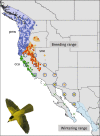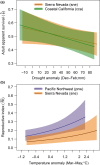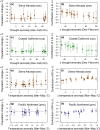Integrating broad-scale data to assess demographic and climatic contributions to population change in a declining songbird
- PMID: 32128118
- PMCID: PMC7042764
- DOI: 10.1002/ece3.5975
Integrating broad-scale data to assess demographic and climatic contributions to population change in a declining songbird
Abstract
Climate variation and trends affect species distribution and abundance across large spatial extents. However, most studies that predict species response to climate are implemented at small spatial scales or are based on occurrence-environment relationships that lack mechanistic detail. Here, we develop an integrated population model (IPM) for multi-site count and capture-recapture data for a declining migratory songbird, Wilson's warbler (Cardellina pusilla), in three genetically distinct breeding populations in western North America. We include climate covariates of vital rates, including spring temperatures on the breeding grounds, drought on the wintering range in northwest Mexico, and wind conditions during spring migration. Spring temperatures were positively related to productivity in Sierra Nevada and Pacific Northwest genetic groups, and annual changes in productivity were important predictors of changes in growth rate in these populations. Drought condition on the wintering grounds was a strong predictor of adult survival for coastal California and Sierra Nevada populations; however, adult survival played a relatively minor role in explaining annual variation in population change. A latent parameter representing a mixture of first-year survival and immigration was the largest contributor to variation in population change; however, this parameter was estimated imprecisely, and its importance likely reflects, in part, differences in spatio-temporal distribution of samples between count and capture-recapture data sets. Our modeling approach represents a novel and flexible framework for linking broad-scale multi-site monitoring data sets. Our results highlight both the potential of the approach for extension to additional species and systems, as well as needs for additional data and/or model development.
Keywords: Avian demography; Cardellina pusilla; Monitoring Avian Productivity and Survivorship; North American Breeding Bird Survey; climate variation; integrated population model; transient life table response experiment.
© 2020 The Authors. Ecology and Evolution published by John Wiley & Sons Ltd. This article has been contributed to by US Government employees and their work is in the public domain in the USA.
Conflict of interest statement
None declared.
Figures







Similar articles
-
Demographic responses to climate-driven variation in habitat quality across the annual cycle of a migratory bird species.Ecol Evol. 2022 Jun 11;12(6):e8934. doi: 10.1002/ece3.8934. eCollection 2022 Jul. Ecol Evol. 2022. PMID: 35784033 Free PMC article.
-
An integrated population model for bird monitoring in North America.Ecol Appl. 2017 Apr;27(3):916-924. doi: 10.1002/eap.1493. Epub 2017 Mar 21. Ecol Appl. 2017. PMID: 28036137
-
A genoscape-network model for conservation prioritization in a migratory bird.Conserv Biol. 2020 Dec;34(6):1482-1491. doi: 10.1111/cobi.13536. Epub 2020 Jul 3. Conserv Biol. 2020. PMID: 32391608
-
Phenology and productivity in a montane bird assemblage: Trends and responses to elevation and climate variation.Glob Chang Biol. 2019 Mar;25(3):985-996. doi: 10.1111/gcb.14538. Epub 2019 Jan 11. Glob Chang Biol. 2019. PMID: 30506620
-
Adcyap1 polymorphism covaries with breeding latitude in a Nearctic migratory songbird, the Wilson's warbler (Cardellina pusilla).Ecol Evol. 2016 Apr 7;6(10):3226-39. doi: 10.1002/ece3.2053. eCollection 2016 May. Ecol Evol. 2016. PMID: 27252831 Free PMC article.
Cited by
-
Spatial consistency in drivers of population dynamics of a declining migratory bird.J Anim Ecol. 2023 Jan;92(1):97-111. doi: 10.1111/1365-2656.13834. Epub 2022 Nov 18. J Anim Ecol. 2023. PMID: 36321197 Free PMC article.
-
Demographic responses to climate-driven variation in habitat quality across the annual cycle of a migratory bird species.Ecol Evol. 2022 Jun 11;12(6):e8934. doi: 10.1002/ece3.8934. eCollection 2022 Jul. Ecol Evol. 2022. PMID: 35784033 Free PMC article.
-
Survival rates in the world's southernmost forest bird community.Ecol Evol. 2023 Jun 20;13(6):e10143. doi: 10.1002/ece3.10143. eCollection 2023 Jun. Ecol Evol. 2023. PMID: 37351480 Free PMC article.
-
Range-wide post- and pre-breeding migratory networks of a declining neotropical-nearctic migratory bird, the blackpoll warbler.Sci Rep. 2024 Dec 4;14(1):30229. doi: 10.1038/s41598-024-80838-9. Sci Rep. 2024. PMID: 39632945 Free PMC article.
-
Juvenile survival of little owls decreases with snow cover.Ecol Evol. 2024 May 20;14(5):e11379. doi: 10.1002/ece3.11379. eCollection 2024 May. Ecol Evol. 2024. PMID: 38770120 Free PMC article.
References
-
- Abadi, F. , Gimenez, O. , Ullrich, B. , Arlettaz, R. , & Schaub, M. (2010). Estimation of immigration rate using integrated population models. Journal of Applied Ecology, 47(2), 393–400. 10.1111/j.1365-2664.2010.01789.x - DOI
-
- Amburgey, S. M. , Miller, D. A. W. , Campbell Grant, E. H. , Rittenhouse, T. A. G. , Benard, M. F. , Richardson, J. L. , … Werner, E. E. (2018). Range position and climate sensitivity: The structure of among‐population demographic responses to climatic variation. Global Change Biology, 24(1), 439–454. 10.1111/gcb.13817 - DOI - PubMed
LinkOut - more resources
Full Text Sources

